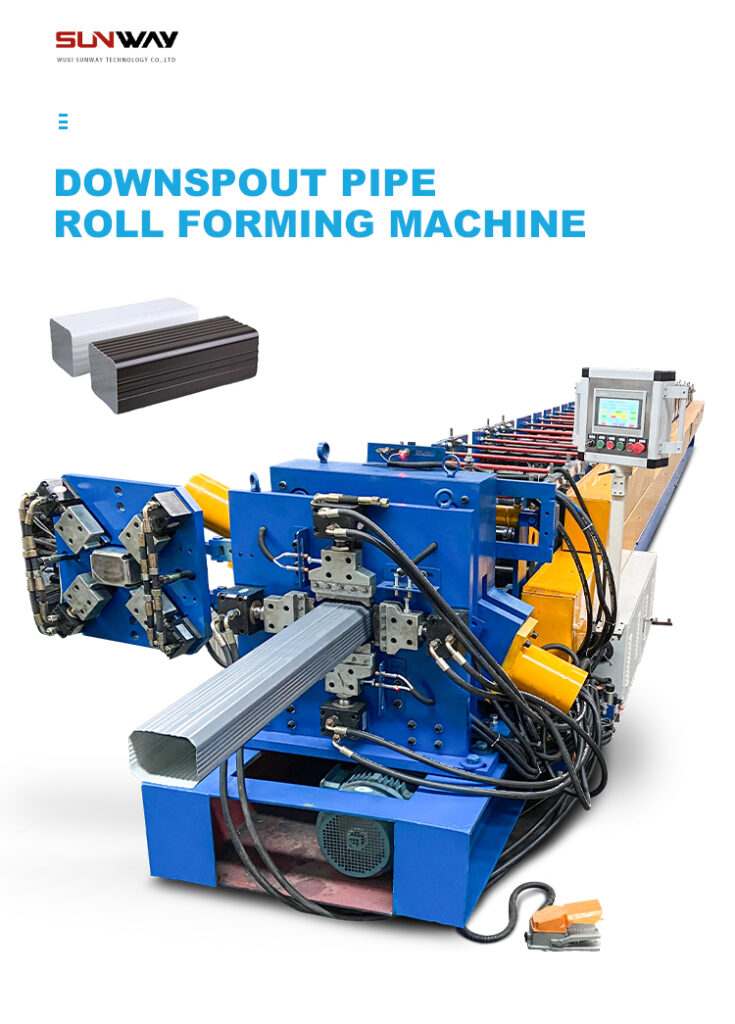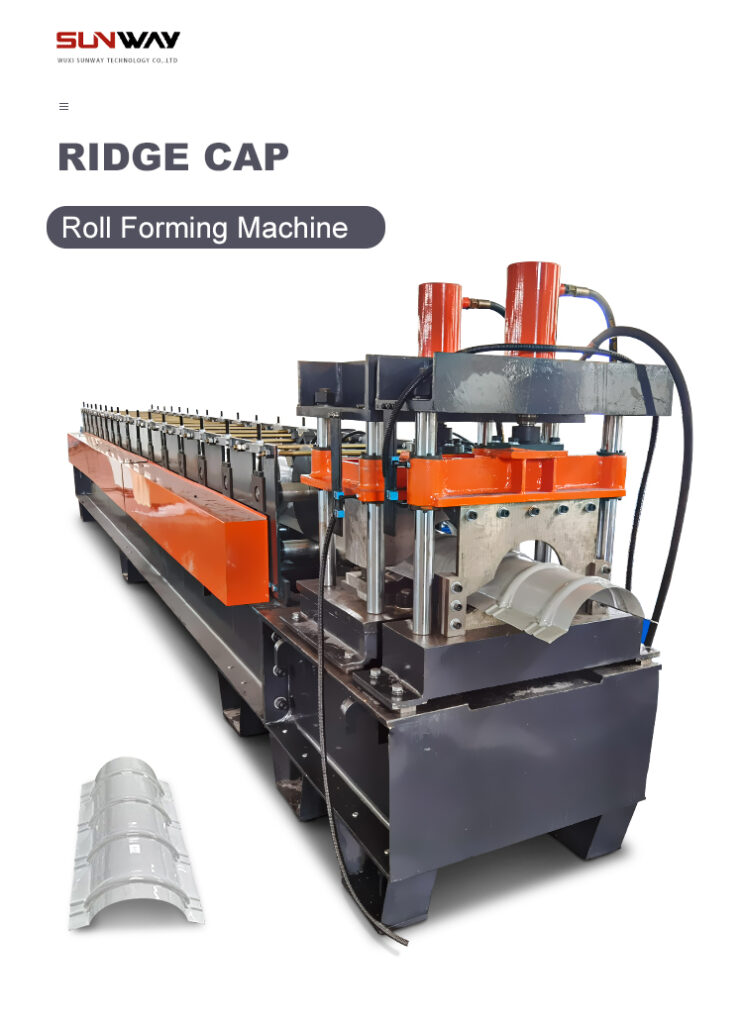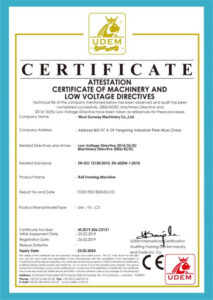А Листогибочная машина для формовки стеновых листов является необходимым оборудованием для производства стеновых панелей, кровельных панелей, обрешетки C & Z и других конструктивных элементов зданий из рулонного металла. В данном руководстве представлен полный обзор технологии рулонной формовки стеновых панелей, типы машин, основные технические характеристики, области применения, требования к установке и обслуживанию, факторы выбора поставщика, сравнительный анализ и часто задаваемые вопросы.
Обзор рулонной формовки стеновых листов
Рулонная формовка - это непрерывная операция гибки, которая формирует рулоны металла в индивидуальные продольные профили с помощью ряда последовательных прокатных клетей. Листогибочные машины превращают плоские металлические листы в готовые стеновые, кровельные и конструкционные каркасные изделия для зданий.
Основные преимущества рулонных стеновых панелей
- Высоконастраиваемые профили
- Превосходная прочность конструкции
- Легкий вес по сравнению с другими стеновыми материалами
- Быстрое и эффективное производство
- Постоянное качество и точность размеров
- Экономичность при массовом производстве
- Минимальное образование отходов
Типы производимых профилей
Машины для формовки стеновых листов могут производить различные стандартные и нестандартные профили в соответствии с требованиями заказчика:
Таблица 1: Распространенные профили рулонных стеновых листов
| Тип профиля | Описание |
|---|---|
| Трапециевидные кровельные и стеновые листы | Волнистый гофрированный профиль, популярный для облицовки |
| Синусоидальные кровельные и стеновые листы | Гладкие изогнутые гофры для эстетичной отделки |
| Кровельные листы со стоячим фальцем | Взаимозаменяемые панели с рельефными швами |
| Ребристые стеновые листы | Узкие продольные ребра для повышения прочности |
| Структурные C и Z обрешетки | Несущие элементы рамы |
| Архитектурные стеновые панели | Декоративные рифленые, изогнутые, текстурированные листы |
| Перфорированные стеновые листы | Отверстия для вентиляции и звукопоглощения |
Основные компоненты устройства для формирования рулонов стеновых листов
Основные секции типичной машины для формовки стеновых профилей включают в себя:
Таблица 2: Компоненты машины для формовки рулонных листов
| Компонент | Описание |
|---|---|
| Разматыватель | Удерживает и вращает металлическую катушку |
| Разматыватель | Выпрямляет ленту из рулона |
| Питатель | Подача ленты с заданной скоростью |
| Перфоратор | При необходимости пробивает отверстия для крепления |
| Станции формовки | Прогрессивные гибочные и профилирующие стенды |
| Режущее устройство | Обрезает листы по заданной длине |
| Штабелер | Автоматически собирает сформированные листы |
| Управление ПЛК | Управление параметрами и блокировками станка |

Технические характеристики рулонных формовщиков стеновых листов
Ключевые технические параметры и размерные факторы определяют производственную мощность, возможности профилирования и производительность машин для формовки рулонных стеновых листов.
Факторы производственной мощности
Таблица 3: Технические факторы, влияющие на производственные мощности
| Параметр | Типовой диапазон |
|---|---|
| Скорость формования | 10 - 25 м/мин |
| Рабочая ширина | 1000 - 2500 мм |
| Толщина листа | 0,3 - 2,0 мм |
| Мощность главного привода | 5,5 - 15 кВт |
| Длина резки | 500 - 6000 мм |
| Предел текучести материала | 250 - 550 МПа |
Более высокая скорость производства, большая ширина рулона, более тонкие калибры и материалы с более низким пределом текучести позволяют ускорить формовку и увеличить производительность.
Размерные факторы профиля
Таблица 4: Технические пределы для профильных форм
| Размер | Типовой диапазон |
|---|---|
| Глубина профиля | 10 - 150 мм |
| Высота волны | 15 - 115 мм |
| Ширина фланца | 45 - 300 мм |
| Ширина ребра | 10 - 45 мм |
| Радиус изгиба | 2 - 8 мм |
| Диаметр перфорации | 10 - 20 мм |
Для глубоких и более сложных форм могут потребоваться более тяжелые машины и многопроходные процессы.
Параметры проектирования и строительства
Таблица 5: Стандартные конструктивные особенности машины
| Характеристика | Описание |
|---|---|
| Станции формовки | 10 - 20 означает последовательное сгибание |
| Типы роликов | Вертикальные, горизонтальные, косые, кромочные ролики |
| Материал ролика | Легированная сталь или твердое хромированное покрытие |
| Диаметр ролика | 100 - 160 мм |
| Регулировка роликов | Шпоночные валы, винтовые соединения, автоматические приводы |
| Рамка | Цельносварная стальная конструкция |
| Руководство по полосам | Роликовые направляющие, экранирование кромок полос |
| Безопасность | Аварийный останов, защита от перегрузки |
| Размер машины | Длина 15 - 40 м; Высота 2 - 2,5 м |
| Уровень шума | ≤80 дБ с акустическими крышками |
Применение машин для формовки рулонных листов
Машины для прокатки стеновых листов производят панели и профили из стали, алюминия и других металлов для следующих конструкционных применений:
Таблица 6: Конечные области применения рулонных стеновых листов
| Приложение | Описание |
|---|---|
| Облицовка стен | Трапециевидные, ребристые и гофрированные листы для наружных стен |
| Кровля | Стоячий фальц, гофрированные кровельные панели |
| Внутренние стены | Декоративные рулонные листы для перегородок |
| Конструктивное обрамление | Прогоны, прогоны, карнизы для зданий |
| Сельскохозяйственные здания | Недорогая кровля и стены для ферм |
| Сборные здания | Ускоренное строительство с помощью готовых панелей |
| Конструкция контейнера | Сборка домов, офисов из рулонных листов |
| Солнечные структуры | Конструкционные профили для крепления фотоэлектрических панелей |
| Акустические барьеры | Звукопоглощающие перфорированные листы |
К основным преимуществам рулонных панелей в этих областях применения относятся легкость, высокая прочность, быстрый монтаж, гибкость конструкции, коррозионная стойкость и долговечность.
Установка и эксплуатация
Правильная установка и эксплуатация являются залогом оптимальной работы линий по производству рулонных стеновых листов.
Руководство по установке
- Фундаменты должны быть бетонными или прочными стальными конструкциями
- Выравнивание и центровка формовочных стендов имеет решающее значение
- Регулировка роликов должна быть точной с равномерными зазорами
- Тестовый запуск для проверки профилей перед производством
- Должны быть установлены защитные барьеры, ограждения и заборы
Эксплуатация и обслуживание
Таблица 7: Требования к эксплуатации и техническому обслуживанию
| Деятельность | Частота |
|---|---|
| Осмотр формованных профилей | Каждый лист или смена |
| Проверьте регулировку ролика | Еженедельник |
| Проверка направления полосы | Ежедневно |
| Смазка подшипников | Ежемесячно |
| Осмотрите цепи, шестерни, звездочки | Ежеквартально или 5000 часов |
| Замените изношенные ролики | После 100 000 циклов или по мере необходимости |
| Калибровка датчиков, исполнительных механизмов | По мере необходимости |
| Обновление программного обеспечения машины | По мере необходимости для модернизации |
Регулярное профилактическое обслуживание повышает качество продукции и позволяет избежать незапланированных простоев.
Соображения по выбору поставщика
Правильный выбор поставщика вальцовочных станков - это ключ к получению надежного оборудования для производства стеновых листов.
Таблица 8: Ключевые критерии оценки поставщиков листогибочных машин
| Параметр | Важность |
|---|---|
| Техническая экспертиза | Высокая |
| Возможности настройки | Высокая |
| Качество сборки и точность | Высокая |
| Опыт интеграции линий | Средний |
| Присутствие и поддержка на местах | Средний |
| Производственная мощность | Низкий |
| Международный опыт | Низкий |
| Конкурентоспособность затрат | Средний |
Помимо технических параметров, при выборе поставщика следует оценивать такие факторы, как оперативность, прозрачность, сроки выполнения заказа, условия оплаты, гарантии и послепродажное обслуживание.
Сравнительный анализ
| Тип машины | Преимущества | Ограничения |
|---|---|---|
| Механическая | Простой и надежный Простое обслуживание Проверенная надежность | Ограниченная способность к формованию Низкая точность Замедление скорости |
| Серводвигатель | Высокая скорость и точность Быстрая переналадка Усовершенствованная автоматизация | Более высокая стоимость Сложное программирование Чувствительные датчики |
| Гидравлический | Мощная сила формования Способность к глубокому рисованию | Уход за маслом Медленнее, чем сервоприводы Экологические риски |
Анализ затрат
Таблица 9: Диапазон цен на оборудование для формовки рулонных листов
| Емкость | Диапазон цен |
|---|---|
| Малые (до 30 000 тонн/год) | $50,000 – $150,000 |
| Средний (до 100 000 тонн/год) | $150,000 – $350,000 |
| Крупные (свыше 100 000 тонн/год) | $350,000 – $1,000,000 |
Стоимость зависит от скорости, ширины, диапазона толщины материала, сложности профиля, уровня автоматизации и требований заказчика. Местная поддержка и транспортные расходы также влияют на цену.

Часто задаваемые вопросы
Какие материалы могут быть использованы для изготовления стеновых листов?
- Холоднокатаная сталь, оцинкованная сталь, нержавеющая сталь, алюминиевые листы толщиной до 2 мм. Не рекомендуется использовать для толстых листов толщиной более 3 мм.
Какими должны быть плоскостность и качество поверхности рулона?
- Допускается допуск плоскостности рулона до 3 мм на метр ширины. Поверхностные дефекты могут маркировать готовые профили.
Каковы требования к питанию?
- Рулонные опалубки для стеновых листов обычно имеют установленную мощность 15 - 30 кВт в зависимости от скорости и производительности. Предпочтительно трехфазное питание 415 В переменного тока.
Как отрегулировать клети для прокатки?
- Стенды регулируются с помощью лазерной центровки или приводов с числовым программным управлением. Шпоночные валы, винты и прокладки обеспечивают ручную регулировку наряду с измерительными станциями.
Какие меры безопасности необходимы?
- Кнопки аварийной остановки, защита от перегрузки, направляющие для удержания ленты, защитные ограждения и световые завесы для остановки при возникновении препятствий. Акустические кожухи снижают уровень шума.
Какие цифровые элементы управления входят в комплект?
- Сенсорные экраны PLC или HMI для контроля производства, настройки параметров и автоматической последовательности работы станка. Сервосистемы обеспечивают точность управления.
Какова нормальная процедура технического обслуживания?
- Ежедневная очистка, еженедельная смазка и осмотр, ежемесячная калибровка датчиков и ежеквартальная замена масла в редукторе - типичные задачи технического обслуживания. Ролики требуют замены по мере износа.
В целом, оборудование для рулонной формовки стеновых листов обеспечивает эффективное, индивидуальное производство металлических стеновых панелей и элементов каркаса зданий. В данном руководстве представлен целостный обзор технологии, процесса, технических характеристик, областей применения, эксплуатации, выбора поставщика и стоимости, чтобы помочь в приобретении и использовании этого универсального оборудования.


